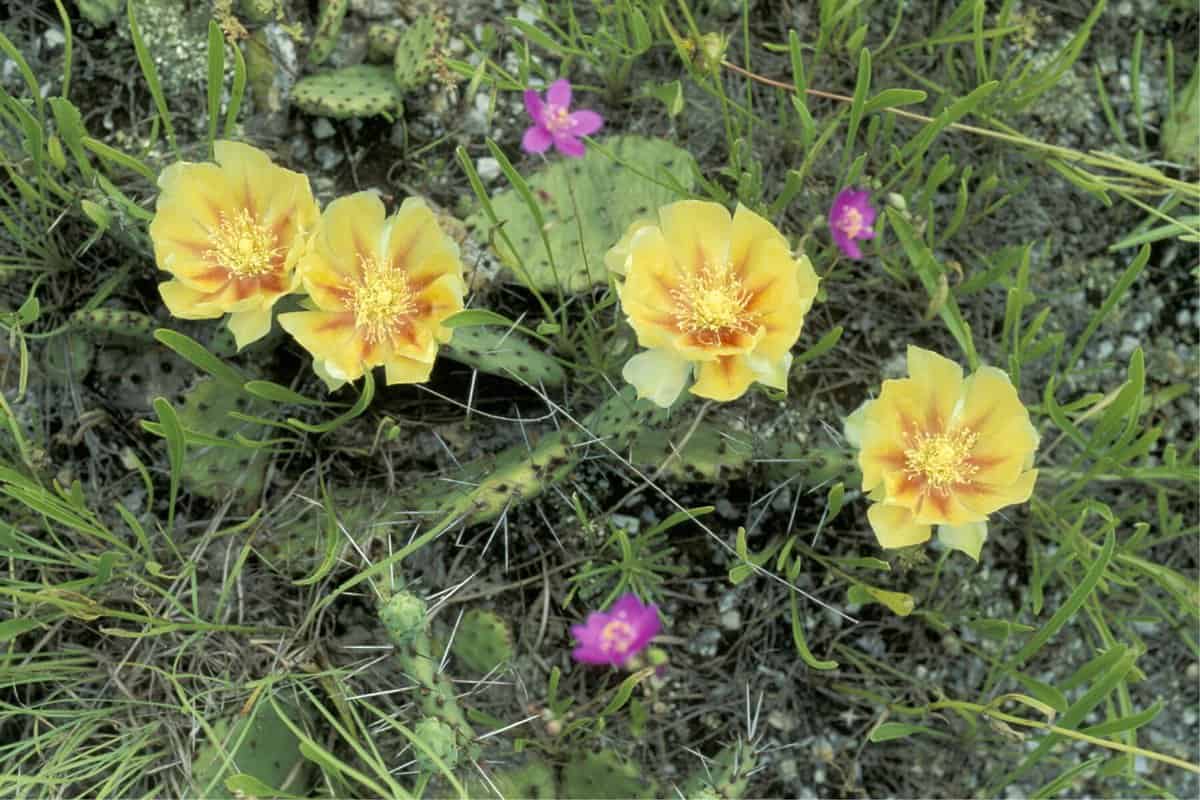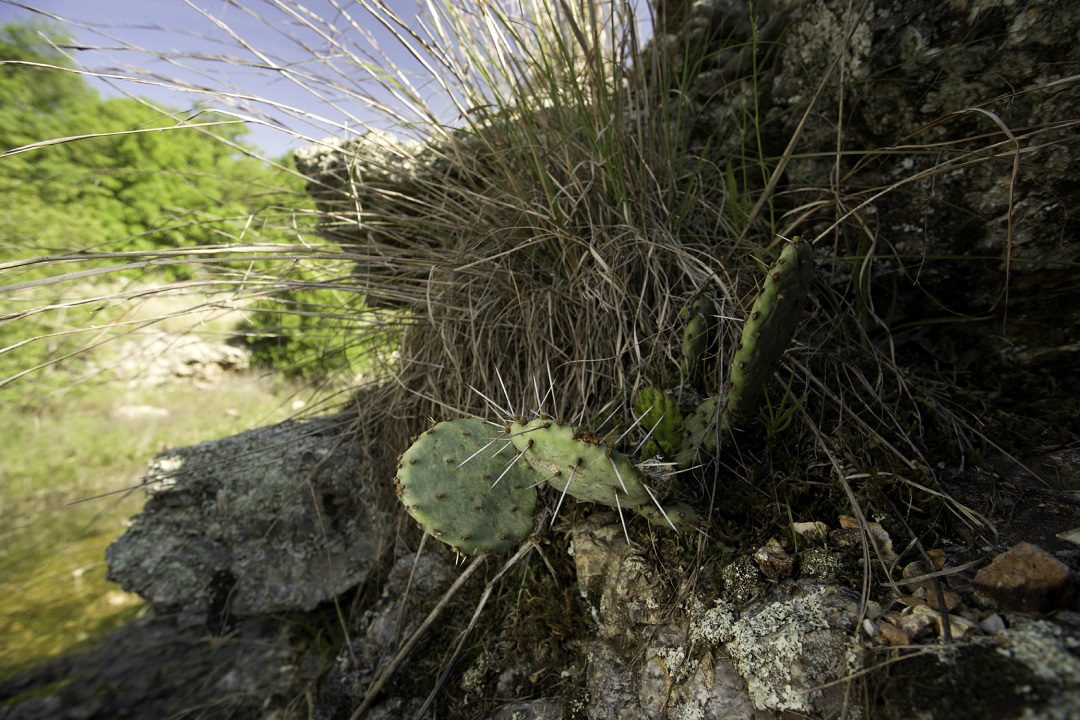When most people think of where a cactus grows, they think of the desert, which is the opposite of Missouri’s humid climate. However, there is a cactus that is native to Missouri. Visitors of Castlewood State Park and Lamotte Sandstone Barrens may have stumbled upon a two-foot-wide plant that resembles a cactus. According to John Vogel, natural history biologist at the Missouri Department of Conservation, Missouri’s native cactus is called the Eastern Prickly Pear, and its scientific name is Opuntia humifusa.
The plant itself is made of roots, pads, fruit, and flowers. According to Vogel, Native Americans used the fruit fresh or dried, the pads roasted like a vegetable, and the sap for medicinal purposes. The fruit is called tuna and the pads are called nopales.
Prickly pear can be found in rocky prairies, pastures, glades, stream terraces, and ridges that receive direct sunlight. This cactus reproduces sexually or asexually and contains antifreeze chemicals, so that it can hibernate during the winter and revive in the spring.
“If you envision a grape turning into a raisin, the pads go through that same process and overwinter that way. In spring, as we get more moisture, those pads start to swell up again and hold more water. It’s not like a plant that has to grow from a seed again the next year,” Vogel said.
Just like any other cactus, the prickly pear has noticeable needle-like spines that could puncture a bike tire. Upon closer inspection, the surface of the cactus reveals small round tufts of bristly hair called areoles. These contain glochids with barbed tips that can easily attach to hiking shoes, camping equipment, human skin, and pet hair. When harvesting the pink fruit or the green pad of the prickly pear, thick gloves are recommended.
The yellow flowers on the prickly pear bloom between May and July, with peak bloom in June. Seasonally, the fruit and the pads of the cactus are usually harvested toward the end of summer and early fall. The cactus uses its pads for photosynthesis, so it’s important to leave some of the pads on the cactus when foraging, so that the plant can survive.

Prickly pear cactus bloom between May and July. (Missouri Department of Conservation)
“When people collect plants out in nature, they may think they are only going to take two, but then 10 more people might have that same idea, so you have to be careful,” Vogel said.
Eastern Prickly Pear is considered an edible wild green and cannot legally be foraged for eating or landscaping purposes from natural areas under the scope of the Department of Natural Resources, Department of Conservation, and National Park Service. However, it is legal to forage up to one gallon of the cactus for personal consumption outside of designated natural areas. Below are four out of many places where the Eastern Prickly Pear can be found.
Hughes Mountain Natural Area
This 462-acre natural area is popular for hiking, bird watching, and hunting. It is located in Washington County south of Potosi via Hwy 21 South and Route M. There is a steep 1- to 2-mile hike from the parking lot that takes hikers to the top of Hughes Mountain, where 1.5-billion-year-old rhyolite rock formations frame a panoramic view of rolling hillsides. Onlookers may also find the Eastern Prickly Pear nestled between rocky glades or sandy stream terraces. Foraging wild edible greens such as the prickly pear at the Hughes Mountain Natural Area is not permitted.
Weldon Spring Conservation Area
Host to the popular Lewis and Clark Trail for hikers and runners, Weldon Spring sprawls across nearly 8,400 acres, includes the Lost Valley Trail, and connects to the Katy Trail. There are various access points to this conservation area from Hwy 94 in St. Charles County. Parts of Weldon Spring are designated as natural areas and others are not. On the map, the natural area is marked in bright green along the Lewis Hiking Trail, where foraging the prickly pear is not permitted. However, it is forageable in other areas of the Weldon Spring Conservation Area.
Don Robinson State Park
This 818-acre state park in Jefferson County hosts two popular day hiking trails — 3.9-mile Sandstone Canyon Trail and 2.4-mile LaBarque Hills Trail — and a special-use camping area that can be accessed via Route 30 West south of Fenton. Foraging is not permitted within Don Robinson State Park, but the Eastern Prickly Pear can be viewed near rocky bluffs and stream terraces. The quiet, shady park is often considered one of the hidden gems of the Missouri State Parks system.
LaBarque Creek Conservation Area
Not to be confused with LaBarque Hills Trail in Don Robinson, LaBarque Creek Conservation Area is an entirely different destination. Aside from the biodiversity of fish found in LaBarque Creek’s watershed, this conservation area is known for hiking trails that traverse bluffs and shelter caves made of sandstone. Eastern Prickly Pear thrives in the sandy soil of this area’s exposed rock ledges. Located in Jefferson County south of Eureka, LaBarque Creek Conservation Area can be accessed via Hwy 109 and Route F. This 1,270-acre land tract is designated as a natural area, which means that foraging wild edibles such as the prickly pear is not permitted.
Author: Aurora Blanchard is a regular contributor to Terrain Magazine.
Top Image: Pricky Pear Cactus grow on a glade at Wildcat Glade Conservation Area near Joplin, Mo. (Missouri Department of Conservation)


Thank you for the information I was wondering what the Cactus was that grew in Wildcat Glade Conservation Area was as I ran across one of the Blooming Flowers a Week ago.